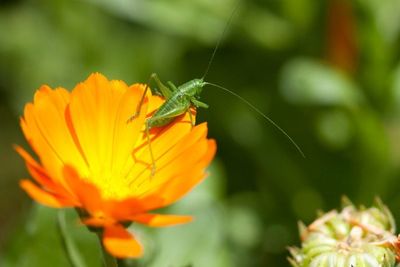Calendula and Insects
While there are a few troublesome pests of calendula, it’s also important to realize that calendula blooms attract a number of beneficial insects. For example, the sweet nectar draws pollinators such as butterflies and bees. Calendula also attracts good guys such as ladybugs, lacewings, hoverflies and other insects that help control aphids, thrips, and other destructive pests. If you walk through your garden in spring and summer, you’re likely to see beneficial insects hanging around your calendula plants.
Does Calendula Attract Pests?
Calendula tends to be a pest magnet. This may sound like a bad thing but look at it this way: If you grow calendula as a “trap crop,” the flowers will draw aphids, thrips, whiteflies, and other harmful pests away from more susceptible plants, like roses or vegetable plants.
Controlling Pests of Calendula
If bugs that eat calendula, such as aphids, whiteflies, and thrips, are out of control and sucking the life out of your calendula plants, insecticidal soap spray will keep them in check, although you may have to apply the soap repeatedly to stay ahead of the pests. Don’t use insecticidal soap when bees, ladybugs, or other beneficial insects are present on the plants; you don’t want to decimate ladybugs and other beneficial insects that help keep pests under control. Removing natural enemies just allows aphids and thrips to flourish. Don’t spray insecticidal soap on hot days or when the sun is directly on the foliage, as doing so may scorch your calendula plants. Slugs also feed on calendula plants. Remove slugs by hand if you aren’t squeamish. Keep the area free of plant debris and limit the depth of mulch, which creates a handy hiding place for slugs. You may need to use a commercial slug bait if your garden is host to a large slug population. Several organic products are now on the market. Cabbage loopers are small caterpillars and they’re easy to remove by hand. Encourage songbirds to visit the garden and they will help you keep cabbage loopers in check. Also, remove plant debris in fall to eliminate sites where pupae tend to overwinter. If you need a little more help keeping cabbage loopers under control, treat them with Bt (Bacillus thuringiensis), a naturally occurring bacteria that kills loopers by paralyzing their digestive system. Avoid pesticides, which nearly always do more harm than good. Finally, while not much of a threat unless found in high numbers, grasshoppers may be seen frequenting calendula plants in the garden. These can easily be picked off. Birds will also feast on these potential pests. If numbers are extreme, Nosema locustae can help.
